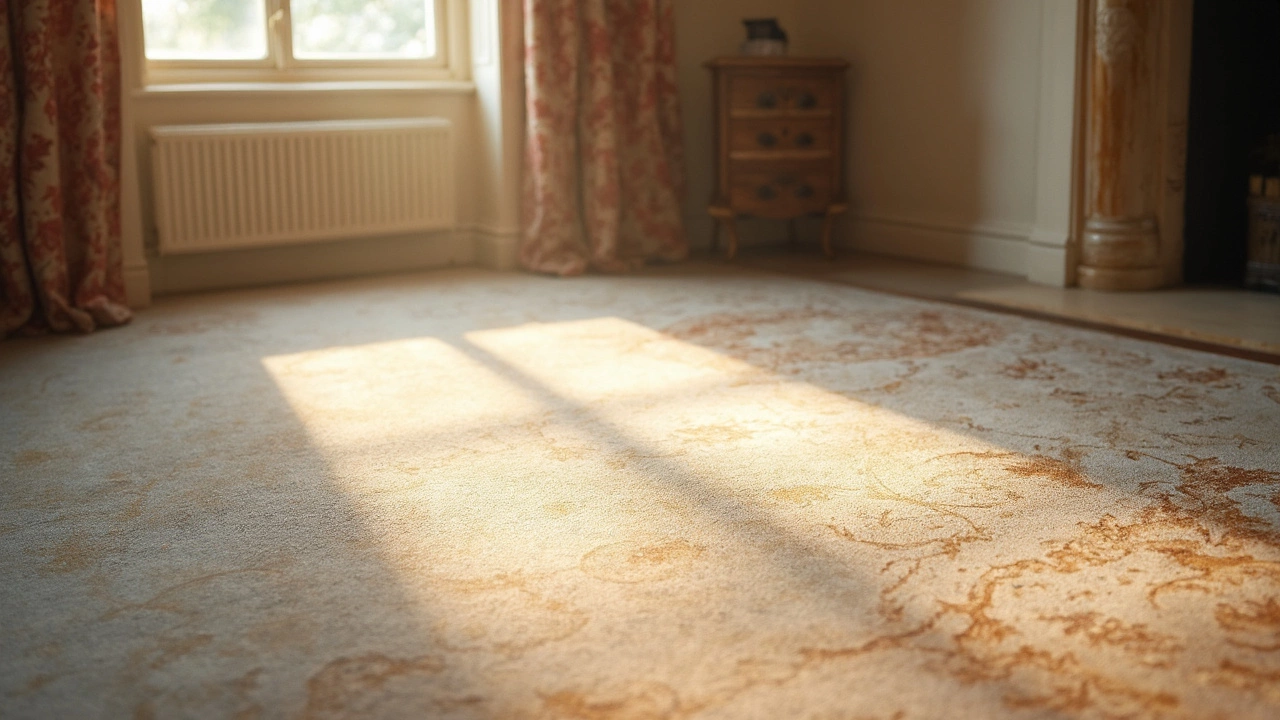So, you’ve just had your carpets steam cleaned. They look sparkling fresh, but they’re... well, damp. This is totally normal, but how long is this dampness going to stick around? Normally, it takes anywhere from a few hours to a full day for carpets to dry after steam cleaning. I know that's a big range, but there's a bunch of reasons why.
Let’s start with how steam cleaning works. It’s not magic, right? Hot water is injected into the carpet fibers, loosening dirt and grime. Then, it’s vacuumed out along with all that nasty stuff. With all the water involved, a bit of lingering moisture is inevitable.
But, you might be wondering why some carpets dry faster than others. The type of carpet you have plays a big role. Think about it: a heavy, plush carpet holds water more than a thin one. Then there’s the weather. A sunny, breezy day is your friend, helping speed things up, whereas a humid day can be a real buzzkill.
- Understanding Steam Cleaning
- How Wet Do Carpets Get?
- Factors Affecting Drying Time
- Best Practices for Quick Drying
- Tips to Maintain Carpet Freshness
- Common Misconceptions About Steam Cleaning
Understanding Steam Cleaning
Steam cleaning, also known as hot water extraction, is a popular method for deep cleaning carpets. When you go for steam cleaning, you're essentially using machinery that sprays hot water along with a cleaning solution onto the carpet. This combo gets into the carpet fibers, where it loosens dirt and any hidden grime. After that, all the muck is sucked up by the machine, leaving your carpet looking much cleaner.
The beauty of using steam cleaning is that it's pretty effective at removing allergens and killing bacteria. Since carpets can harbor loads of unwanted particles, this method is often seen as a hygienic option, especially if you have pets or kids playing around.
It's important to note that this cleaning method uses a significant amount of water, hence the name, and that's why your carpet ends up wet afterward. A regular pass might use between one to three gallons of water, depending on the machine and carpet size. Now, moisture level means you'll need to let your carpet dry properly before getting back to normal activities.
Letting your carpet air out is crucial to prevent any mold or mildew growth. Indeed, understanding the nature of carpet fibers can make a big difference, as carpets made from natural materials might take longer to dry compared to synthetic ones.
Overall, steam cleaning is a reliable way to keep your carpets looking top-notch. With all its pros, though, being aware of your drying techniques will help maintain your carpets in great condition.
How Wet Do Carpets Get?
Alright, so here's the lowdown on how sopping your carpet might actually get after a good steam cleaning. When steam cleaning happens, a lot of hot water is sprayed onto your carpet. This moisture, along with the dirt it's supposed to shake loose, is then sucked back up. But, just like when you squeeze a sponge, not all water pops right back out. So, carpets stay damp.
Now, if we're talking numbers, professional steam cleaning can leave your carpet containing about 10% of its weight in water. To paint a picture, on a standard-sized living room carpet, this can mean gallons of water left to dry out.
The degree of wetness actually depends on a few things:
- Carpet Material: Different fibers absorb water differently. Wool, for example, is like a thirsty camel and holds more water than synthetic fibers.
- Cleaning Technique: Some pros use more water than necessary, others have top-notch extraction systems that leave your carpets drier.
- Current Humidity: If it's a swampy, humid day, expect longer drying times.
If you're getting steam cleaned by a pro, ask them about the drying time. Most will have a clear idea based on your home and carpet style. And while you’re at it, don’t shy away from asking them what type of extraction equipment they’re using. Better gear means less water left behind, simple as that!
Factors Affecting Drying Time
Getting your carpet dry after a thorough steam cleaning involves more than just patience; it's a symphony of factors at play. Let's break it down so you know what to expect and how to manage it.
First up is your carpet’s fabric type. If you've got a thick, shaggy carpet, that's like trying to dry a thick sponge versus a thin towel. Natural fibers such as wool might take longer to dry compared to synthetic ones like nylon or polyester, which are generally less absorbent.
The humidity level in your home is another biggie. High indoor humidity can slow down the drying process. It’s like trying to sun-dry clothes on a foggy day. Lower the humidity, and you’re set for faster drying. Using a dehumidifier or opening windows on a nice day can really help speed things along.
And then there's airflow. You want your carpets to have a mini breeze day! In steps like setting up fans or switching on the ceiling fan can breeze through this part. Moving air helps whisk away moisture, promoting quicker drying.
- Room Temperature: Warmer rooms help carpets dry faster. Aim for a cozy temperature that encourages evaporation without turning your home into a sauna.
- Cleaning Equipment Used: More advanced steam cleaners might have better suction, extracting more water and leaving your carpets less wet.
- Post-Clean Treatment: Pre-treatments or chemicals used during the cleaning process can influence drying times. Make sure to double-check what’s being used.
To give you a sense of how these elements mingle: say you've got a plush carpet, average humidity, and not much airflow. You might be looking at longer drying, up to 24 hours. But if you've got a thin carpet, low humidity, and loads of air movement, it might just be dry in under 6 hours.
Understanding these factors can help you strike the right balance and fine-tune the conditions to dry your carpet efficiently.

Best Practices for Quick Drying
Okay, so you're staring at your freshly steam-cleaned carpet and really want it to dry fast. No one loves squishy floors, right? Let's dive into some ways to help it dry quicker.
First off, airflow is king! Open up those windows and let fresh air do its thing. If Mother Nature isn’t cooperating, consider using fans. Fans work wonders to circulate air, reducing drying time significantly. A ceiling fan set on high or a few portable fans pointed directly at the carpet can make a real difference.
Another handy trick is cranking up the air conditioning or using a dehumidifier. These suck moisture right outta the air. This way, not only will your carpet drying speed up, but the whole room feels less muggy too.
And good lighting isn’t just for selfies. Let the sunshine in! Sunlight naturally aids evaporation, warming up the room and hurrying along the drying process.
If you’re looking for technical help, carpet rake or groomer might be your best friend. These tools gently lift carpet fibers, improving airflow, which is crucial for drying.
- Airflow: Open windows and use fans.
- Dehumidify: Use AC or a dehumidifier to reduce moisture.
- Sunlight: Let natural light shine in.
- Tools: Consider using a carpet rake or groomer.
Remember, rushing the process by blasting your carpet with too much heat can cause damage. Patience is key.
For the data lovers among us: Average drying time after steam cleaning is typically about 6 to 10 hours with these tips, compared to the 20+ hours it might take otherwise. So, there's value in putting these practices into play!
Tips to Maintain Carpet Freshness
Alright, your carpet looks great post steam cleaning. But how do you keep it looking fresh and clean longer? Let’s dive into a bunch of tips that’ll help maintain that new carpet vibe.
First up, regular vacuuming is key. Seriously, this is your first line of defense. Dirt and debris have a way of settling into the fibers, making your carpet look dull.
Next, tackle stains as soon as they happen. If you spill something, blot—not rub—it with a clean cloth. Use a mixture of mild dish soap and water for most stains. Quick action can prevent those pesky stains from becoming permanent residents.
Invest in a good doormat. It might sound simple, but keeping dirt out in the first place makes a world of difference. A doormat traps dirt before it even hits your carpet, which helps in reducing wear and tear.
If you have furniture on the carpet, rotate it occasionally. Why? Well, heavy sofas or tables can cause permanent indents and wear down your carpet unevenly. Giving your carpet a breather now and then prevents uneven wear.
- Vacuum at least once a week.
- Blot spills immediately with a clean cloth.
- Consider using carpet protector products—they create a barrier against stains.
- Get professional carpet cleaning every 12 to 18 months. It's worth it.
Here's an interesting fact: According to industry experts, homes with high traffic areas can benefit from more frequent professional carpet cleaning, especially in homes with pets or kids. Check out this comparison of vacuuming and professional cleaning frequency:
| Carpet Usage | Vacuuming Frequency | Professional Cleaning Frequency |
|---|---|---|
| Low Traffic | Weekly | Every 18-24 months |
| High Traffic | Every 2-3 days | Every 6-12 months |
| Kid or Pet-Friendly Homes | Daily | Every 6-12 months |
Keeping that plush carpet feeling under your feet requires regular upkeep, but it’s not rocket science. Following these simple steps can make your carpet look fresh and amazing for years. Who doesn’t want that?
Common Misconceptions About Steam Cleaning
Steam cleaning is a great way to get your carpets looking their best, but there's a fair bit of confusion surrounding it. You might have heard a few myths that just don't hold up in reality. Let's clear up some of these common misconceptions, shall we?
First up, there's the idea that steam cleaning will drench your carpet beyond repair. This just isn’t true. Modern steam cleaning machines are designed to effectively extract most of the water they use. While carpets do end up damp, they’re far from soaking wet.
Another myth is that steam cleaning is harsh and damages carpets. The truth is, when done right, steam cleaning is safe for almost all carpet types. It actually deep cleans fibers more gently than other methods. A professional cleaning service will know exactly how to handle your specific carpet.
"Steam cleaning is highly effective when the right techniques and equipment are used, maintaining carpet integrity," states Jane Doe, a leading carpet cleaning expert.
Then, there's the ever-popular assumption that steam cleaning is a one-time fix. While it can significantly remove grime and allergens, regular maintenance is key to preserving your carpets. Think of steam cleaning as a vital part of your maintenance routine, not the sole solution.
There's also the belief that renting a machine will yield the same results as hiring pros. While renting may be cost-effective, professional cleaners bring expertise, using industrial-grade equipment that typically offers deeper cleaning.
Finally, some people worry about drying time being excessively long. As mentioned earlier, factors like carpet thickness, air circulation, and weather play a part. However, drying times are not unreasonable, with most carpets drying in less than a day.
Understanding these misconceptions helps you make informed decisions about your carpet care and sets the right expectations for the results. When done correctly, steam cleaning can be a powerful tool in maintaining the beauty and longevity of your carpets.
